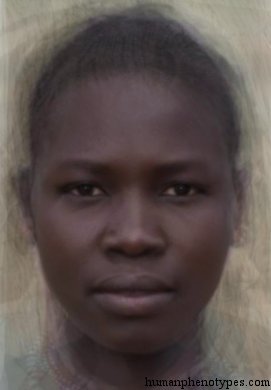Description
Specialised African type, native to the swamps and savannahs of the Upper Nile region in South Sudan and adjacent countries. With their black skin they belong to the darkest people on Earth. Their thin bodies are the tallest of all indigenous human groups worldwide who are still alive, their legs longer than in any other known group.
Only poverty and malnutrition keep individuals below their genetic height-potential. Heads long, facial features coarse with a rather wide nose, full lips, and kinky hair. Prognathy weak. Nilotids seem to be a relatively old group that might have extended further East into Ethiopia during prehistoric periods.
Varieties
The most typical variety is the Dinkaid, native to swamp regions. A similar savannah counterpart is the Shillukids. South Nilotids show less pronounced features, possibly due to admixture. In Chad, the admixed West Nilotid Shari type is found. An very ancient variety still exists between Sudan and Ethiopia: the Pre Nilotid.
Physical Traits
Height: Tallest worldwide
Build: Thin, slender
Legs: Longest proportions
Skull: Long
Face: Coarse features
Nose: Rather wide
Lips: Full
Skin: Black (darkest on Earth)
Hair texture: Kinky
Prognathy: Weak
The Nilotid type represents one of the most distinctive and specialized human phenotypes. The combination of extreme height with very thin build creates the most linear body proportions found in any human population. Leg length relative to torso is greater than in any other group, representing a classic adaptation to hot climates (Allen's rule). The very dark black skin places them among the darkest-skinned peoples on Earth. Facial features are characterized by long heads, rather wide noses, full lips, and kinky hair texture typical of African populations. Unlike some other African types, prognathy is relatively weak. The extreme height potential is often unrealized due to nutritional limitations in their native regions.
Literature References
The Nilotid type has been extensively documented in anthropological literature due to its distinctive physical characteristics, particularly the extreme height and body proportions.
- Montandon (1933) - Nilocharienne
- Eickstedt (1934, 1952) - Nilotid
- Hooton (1946) - Nilotic Negro
- Cole (1965) - Nilotes
- Biasutti (1967) - Nilotica
- Lundman (1967, 1988) - Nilid
- Vallois (1968) - Nilotique
- Debets (1974) - Nilotic
- Vogel (1974) - Nilotid
- Knussmann (1996) - Nilotid






